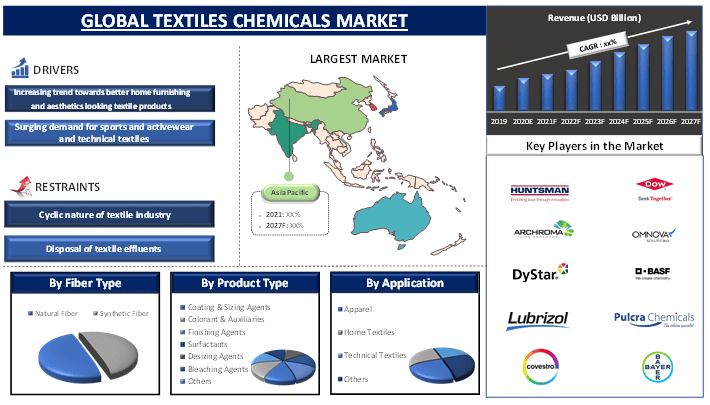- Home
- About Us
- Industry
- Services
- Reading
- Contact Us
Textile Chemicals Market: Current Analysis and Forecast (2021-2027)
Emphasis on Fiber Type (Natural Fiber and Synthetic Fiber); Product Type (Coating & Sizing Agents, Colorant & Auxiliaries, Finishing Agents, Surfactants, Desizing Agents, Bleaching Agents, and Others); Applications [Apparels (Sportswear, Intimates, Outerwear), Home Textiles (Bed Linens, Carpet, Curtains, Others), Technical Textiles and Others)]; and Region/Country

Textile Chemicals Market was estimated to be around 26 billion in 2020 and is anticipated to display a CAGR of above 4% over the forecast period (2021-2027). Presence of surplus number of manufacturing companies is creating a competitive environment for manufacturers globally. Although upward shift in the demand of apparels, home textiles, technical and medical textiles would allow the textile market to expand. According to India Brand Equity Foundation, Indian technical textiles market is expected to expand to USD 23.3 Bn by 2027. This is mainly owing to increasing demand of technical and medical textiles from healthcare and hospitality industry. Since chemicals are extensively used in textile industry to provide a wide variety of attractive shades, comfortable, wrinkle free, soft handle and high durability.
Thus, linearly growing textile market would lead to the growth of textile chemicals market. Furthermore, globally key players are adopting numerous strategies such as product launch, business expansion, acquisition, partnership, collaboration, joint venture, and agreement to stay competitive in the technical textile market. For instance, Huntsman Textile Effects and Phong Phu International (PPJ) in 2020, announced a strategic partnership agreement that aims to promote PPJ’s growth in Vietnam as a leading manufacturer of sustainable, high-performance textiles and garments for many of the world’s leading brands and retailers.
Huntsman International LLC, Dow Chemical Company, DyStar Textilfarben GmbH, Bayer AG, Pulcra Chemicals GmbH, Archroma Management GmbH, Omnova Solutions Inc., The Lubrizol Corporation, Covestro AG, BASF SE. are some of the prominent players operating in the textile chemicals market. Several M&As along with partnerships have been undertaken by these players to facilitate customers.
Insights Presented in the Report
“Amongst Fiber Type, Natural Fiber category likely to witness significant growth rate.”
Based on fiber type, textile chemicals market is bifurcated into natural and synthetic fiber. Green chemicals are produced using animal and plant fats/oils, which not only makes them eco-friendly but also cost-efficient as compared to their conventional counterparts. Due to increase in awareness toward environmental pollution caused by synthetic materials the natural fiber segment is expected to grow at a significant growth rate during the forecast period. Furthermore, companies involved in manufacturing bio-based chemicals offer cost competitiveness owing to the availability of low-cost feedstock.
“Amongst Product Type, Colorant and Desizing Agents held lucrative market share in 2020.”
Based on product type, textile chemicals market in divided into coating & sizing agents, colorant & auxiliaries, furnishing agents, surfactants, desizing agents, bleaching agents, and others. Among all, desizing and colorants holds a considerable market share. This is mainly due to their extensive usage in large segment of textiles. Although, furnishing agents also hold a prominent market share for premium aesthetic textiles manufacturing.
“Amongst Application, Apparels and Home Textiles Categories hold the prominent market share.”
On the basis of application, textile chemicals market is divided into apparels, home textiles, technical textiles, others. Currently, apparels and home textiles hold considerable market share which is mainly owing higher purchasing power of end users. Further, Covid-19 propelled the demand for sportswear. During lockdown majority of population opted to wear comfortable apparels thereby escalating the demand for textile chemicals used in apparel category.
“Asia Pacific represents as the prominent market in the Textile Chemicals market.”
For better understanding of the market penetration of textile chemicals, the report provides a detailed analysis of major regions including North America, Europe, Asia Pacific, and the rest of the world. Asia Pacific to lead growth owing to increased penetration of organized retail, favorable demographics and increasing purchasing power of end users is driving the textile industry grow at a very substantial rate. Since chemicals are the mainstream for textile industry and are widely used as bleaching agents, surfactants, finishing agents, etc. Expansion of textile industry would propel the market size of textile chemicals market. According to India Brand Equity Foundation, in 2020, market size of textiles and apparel industry was observed to be USD 150 Bn and is expected to grow to USD 220 Bn by 2026. Therefore, owing to this the textile chemicals market would grow exponentially in the region.
Reasons to buy this report:
- The study includes market sizing and forecasting analysis validated by authenticated key industry experts
- The report presents a quick review of overall industry performance at one glance
- The report covers an in-depth analysis of prominent industry peers with a primary focus on key business financials, product portfolio, expansion strategies, and recent developments
- Detailed examination of drivers, restraints, key trends, and opportunities prevailing in the industry
- The study comprehensively covers the market across different segments
- Deep dive country-level analysis of the industry
Customization Options:
Textile Chemicals Market can further be customized as per the requirement or any other market segment. Besides this, UMI understands that you may have your own business needs, hence feel free to connect with us to get a report that completely suits your requirements.
Table of Content
Analyzing the historical market, estimation of the current market, and forecasting the future of the global textile chemicals adoption were the three major steps undertaken to create and analyze the adoption of textile chemicals across various segments in North America, Europe, Asia Pacific, and Rest of the world. Exhaustive secondary research was conducted to collect the historical market numbers and estimate the current market size. Secondly, to validate these insights, numerous findings and assumptions were taken into consideration. Moreover, exhaustive primary interviews were also conducted, with industry experts across the value chain of the textile chemicals sector. Post assumption and validation of market numbers through primary interviews, we employed a top-down/bottom-up approach to forecast the complete market size. Thereafter, market breakdown and data triangulation methods were adopted to estimate and analyze the market size of segments and sub-segments the industry pertains to. Detailed methodology is explained below:
Analysis of Historical Market Size
Step 1: In-Depth Study of Secondary Sources:
Detail secondary study was conducted to obtain the historical market size of the textile chemicals through company internal sources such as annual report & financial statements, performance presentations, press releases, etc., and external sources including journals, news & articles, government publications, competitor publications, sector reports, third-party database, and other credible publications.
Step 2: Market Segmentation:
After obtaining the historical market size of the textile chemicals market, we conducted a detailed secondary analysis to gather historical market insights and share for different segments & sub-segments for major regions. Major segments included in the report as fiber type, product type, and application. Further regional & country-level analyses were conducted to evaluate the overall adoption of the textile chemicals in the global context.
Step 3: Factor Analysis:
After acquiring the historical market size of different segments and sub-segments, we conducted a detailed factor analysis to estimate the current market size of textile chemicals. Further, we conducted factor analysis using dependent and independent variables such as shifting fashion trends. A thorough analysis was conducted for demand and supply-side scenario considering top partnerships, merger and acquisition, business expansion, and product launches in the textile chemicals industry.
Current Market Size Estimate & Forecast
Current Market Sizing: Based on actionable insights from the above 3 steps, we arrived at the current market size, key players in the global textile chemicals market, and market shares of the segments. All the required percentage split, and market breakdowns were determined using the above-mentioned secondary approach and were verified through primary interviews.
Estimation & Forecasting: For market estimation and forecast, weights were assigned to different factors including drivers & trends, restraints, and opportunities available for the stakeholders. After analyzing these factors, relevant forecasting techniques i.e., bottom-up approach was applied to arrive at the market forecast to 2027 for different segments and subsegments across the major regions globally. The research methodology adopted to estimate the market size encompasses:
- The industry’s market size, in terms of value (US$) and the adoption rate of textile chemicals across the major markets
- All percentage shares, splits, and breakdowns of market segments and sub-segments
- Key players in the textile chemicals market in terms of revenue generated. Also, the growth strategies adopted by these players to compete in the fast-growing market.
Market Size and Share Validation
Primary Research: In-depth interviews were conducted with the Key Opinion Leaders (KOLs) including Top Level Executives (CXO/VPs, Sales Head, Marketing Head, Operational Head, and Regional Head, Country Head, etc.) across major countries. Primary research findings were then summarized, and statistical analysis was performed to prove the stated hypothesis. Inputs from primary research were consolidated with secondary findings, hence turning information into actionable insights.
Split of Primary Participants in Different Regions

Market Engineering
Data triangulation technique was employed to complete the overall market estimation and to arrive at precise statistical numbers of each segment and sub-segment of the global textile chemicals market. Data was split into several segments & sub-segments post studying various parameters and trends in the areas of fiber type, product type, and application.
The main objective of the textile chemicals market study
The current & future market trends of textile chemicals were pinpointed in the study. Investors can gain strategic insights to base their discretion for investments from the qualitative and quantitative analysis performed in the study. Current and future market trends determine the overall attractiveness of the market at a global & country level, providing a platform for the industrial participant to exploit the untapped market to benefit as a first-mover advantage. Other quantitative goals of the studies include:
- Analyze the current and forecast market size of textile chemicals in terms of value (US$). Also, analyze the current and forecast market size of different segments and sub-segments
- Segments in the study include areas of fiber type, product type, and application. Defined analysis of the regulatory framework for the textile chemicals industry
- Analyze the value chain involved with the presence of various intermediaries, along with analyzing customer and competitor behaviors of the industry
- Analyze the current and forecast market size of the textile chemicals for the major regions & countries
- Major regions studied in the report include North America, Europe, Asia Pacific, and Rest of World
- Company profiles of the textile chemicals market players and the growth strategies adopted by them to sustain in the fast-growing market
- Deep dive regional & country level analysis of the industry
Related Reports
Customers who bought this item also bought










